|
|
After the collapsing at Volga, the Germans were far from being finished. It was still an excellent army with very well trained soldiers and superior equipment. Germans still had brilliant generals and good industrial base, all of Europe. They still had all the resources of Europe and western territories of the USSR (although in some invaded areas of the USSR partisans had more control than the occupational troops).
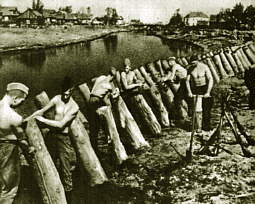 Soviet infantry preparing the anti-tank fortifications. Kursk 1943. (RGAKFD) |
By the middle of the March 1943 the front line stabilized again, after Germans had recaptured Kharkov. The city was to the south of a large salient held by the Russians (near Kursk). To the north of the salient there was also German held Orel. The salient was about 180 kilometers wide and went for about 120 kilometers into German front. That was a logical place for Germans to strike and of course Russians could figure out the intentions of the other side. In this time Soviet High Command had two ways: to lauch a massive offensive with forces of 5 fronts, or build a stong defense and exhaust all German forces, and then stike with a forces of three frons. The first way was maintained by N.Vatutin, N.Khruschev and A.Vasilevskiy. The second way was maintained by K.Rokossovskiy, M.Malinin. The problem was resolved when G.Zhukov took the Rokossovskiy's side. Marshal Zhukov convinced Stalin not to launch a premature offence (like in case with Kharkov), but rather wait for Germans to make the first move.
Both Russians and Germans began building up their forces at the salient. There were no battles before comparable in terms of armor concentration. The opposing sides gathered there about 7000 tanks and self-propelled guns. In some places the density of tanks was about one tank for every 10 metres (100 tanks per kilometer of the front). On the northern part of the salient the concentration of tanks was one for every 30 metres. And on the southern part Germans put nine their best divisions! Wehrmacht planned to engage about a million soldiers for the Kursk offensive (named as operation "Citadel" or "Zitadelle").
The coming battle was seen as a way to regain initiative lost after the Stalingrad. Hitler placed a lot of emphasis on the importance of the offensive for the Third Reich, he sent a message to the soldiers before the attack: "This day you are to take part in an offensive of such importance that the whole future of the war may depend on its outcome".
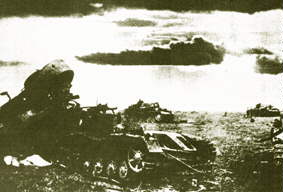 Battlefield. Kursk 1943. (TzAMO) |
The Kursk battle began early morning, on July 5, 1943. Russian intelligence knew the time when Wehrmacht was to begin the offensive, and this time, unlike early morning of June 22, 1941, Soviet Army was ready to face the enemy. Many German tanks were gone in the first 700 metres, because of mines. Russian guns stepped in... The first day 586 German tanks were destroyed or damaged beyond repair.
Next day Germans threw in their reserves. The concentration of the tanks was so high, that Soviet and German machines were practically colliding here and there. Medics could not handle the numbers of wounded. The battlefields were covered all over with tanks, some still operating, some already burning...
On the July 8 Germans were close to making it through the anti-tank defense system. They pushed hard, but Russians fought back as hard. Germans threw everything they had - but Russians held.
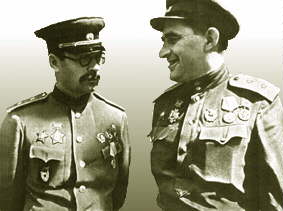 General P.A.Rotmistrov (left) and General A.S.Zhadov (RGAKFD) |
The major action of the Kursk battle took place at the Prokhorovka village. There Germans put all the cream of their army: SS units of Totenkopf, Adolf Hitler and Das Retch, five Panzer divisions, Gross Deutschland and three infantry divisions. The Russian defense was broken and German tanks drove to the Prokhorovka. The Russian front begun quickly collapsing and falling in pieces. To stop this the Soviet High Command put in action two armies: Zhadov's 5th Guard Army and Rotmistrov's 5th Guard Tank Army. The little village clearly became the epicenter of the Kursk battle.
There was a rough parity in terms of tank strength (of course, it's not only numbers that matters, it's the equipment quality too). German Tigers had heavier armor than Russian T-34/76, but T-34 had a better maneuverability. The space where all the fighting occurred was a tiny area about 4 to 6 kilometers. The tanks engaged into individual duels. It was a mash of people and steel. Germans learned quickly that Russians are tough in tenacious in fighting, but it was a psychological side of the war. At the Prokhorovka Germans perhaps first time from the beginning of the war experienced the strength of the Soviet Army in terms of weaponry. It was not a single battle like many people tought. There were a serious battles along the 32km front. All these battles called as "Battle at Prokhorovka" just because of main direction of the German's blow and late the main direction of Soviet counter-offensive. The battles countinues from 11 to 14 July. Total German's casualties were over 300 tanks. The 5th Guard Tank Army also had heavy losses.
| Soviet counter-offensive at Prokhorovka |
|---|
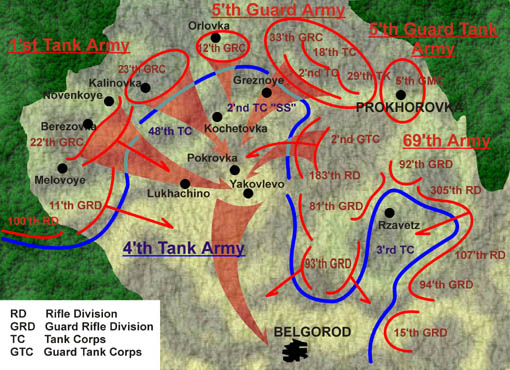 |
At the Kursk battle Germans lost almost twice as many men in a week as Americans lost in the three years of the Vietnam War. After Kursk, Wehrmacht was not able to launch another major offence. Now the initiative was clearly on the Russian side...
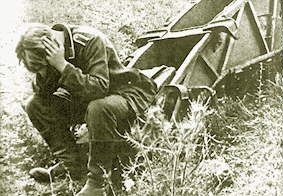
|
|